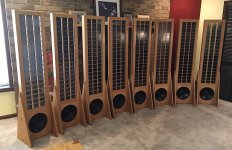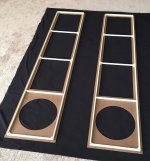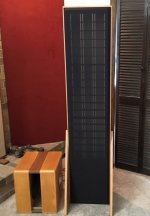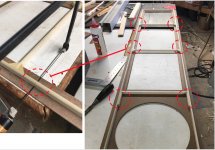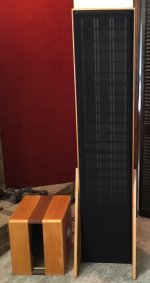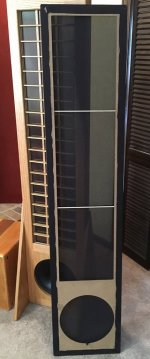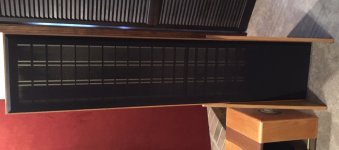Hi Charlie ...
Before writing more just a brief preamble: About a year ago I completed a CNC mill for making my various audio projects. It works reasonably fine & it allows me to work in most all materials & do many different items. However, I have learned sort of the hard way that it is not enough to draw the items in the 3D modeling software and "then machine them" - setup, rotating, orienting, changing tools etc., etc. all takes time ...
So, when I see the picture of your 8 speakers, and watch the video with an eye for details, I am impressed. Looks like very fine craftsmanship and a lot of work ;-)
Cheers,
Jesper
Before writing more just a brief preamble: About a year ago I completed a CNC mill for making my various audio projects. It works reasonably fine & it allows me to work in most all materials & do many different items. However, I have learned sort of the hard way that it is not enough to draw the items in the 3D modeling software and "then machine them" - setup, rotating, orienting, changing tools etc., etc. all takes time ...
So, when I see the picture of your 8 speakers, and watch the video with an eye for details, I am impressed. Looks like very fine craftsmanship and a lot of work ;-)
Cheers,
Jesper
Thanks so much for continuing to share your ESL endeavors.
Looking awesome!


It's mentoring from you, Golfnut, Calvin and others on this forum that made this project possible for me. I'm just happy to pay it forward!
Gentlevoice, Clog,
Thanks so much for the compliments on my speakers. This project was so much work; it just may be my swan song!
Ani,
Hello Ani101,
My DIY ESL website (link below) has extensive how-to info-- mostly gleaned from the members on this forum. I share my drawings with anyone who wants them and I enjoy collaborating with other builders.
As you can see; building wire-stator ESLs involves a huge amount of work and some woodworking capability as well. But if you're up for the challenge; I and others here are happy to help. You may find it rather a psychosis
Charlie
jazzman1953@gmail.com
Thanks so much for the compliments on my speakers. This project was so much work; it just may be my swan song!
Ani,
Hi Charlie
I have followed your build for the ESL speakers which are on your site and always wanted to build an ESL speakers.
I am interested in the drawings and parts list and would like to attempt these sometime this year, but may need to ask you from time to time...
Hello Ani101,
My DIY ESL website (link below) has extensive how-to info-- mostly gleaned from the members on this forum. I share my drawings with anyone who wants them and I enjoy collaborating with other builders.
As you can see; building wire-stator ESLs involves a huge amount of work and some woodworking capability as well. But if you're up for the challenge; I and others here are happy to help. You may find it rather a psychosis
Charlie
jazzman1953@gmail.com
Last edited:
This is an amazing project and the amount of details Charlie M has shared is abundant. I can only gain so much from the videos but they seem to have an effortless sound and wish I could hear a pair myself.
If you could compare them to another panel type speaker, what would be a contender? Or are these best you've heard? I wouldn't be surprised to hear that. Regardless, they are works of art, and accomplish what some speakers fail to do. Very classy.
If you could compare them to another panel type speaker, what would be a contender? Or are these best you've heard? I wouldn't be surprised to hear that. Regardless, they are works of art, and accomplish what some speakers fail to do. Very classy.
This is an amazing project and the amount of details Charlie M has shared is abundant. I can only gain so much from the videos but they seem to have an effortless sound and wish I could hear a pair myself.
If you could compare them to another panel type speaker, what would be a contender? Or are these best you've heard? I wouldn't be surprised to hear that. Regardless, they are works of art, and accomplish what some speakers fail to do. Very classy.
I'm very fond of Magnapans, which I think sound generally great and they have an edge over ESLs in the lower end of their bandwidth. However; I prefer ESLs because to my ears they are the finest midrange drivers ever. And ESLs in general, not just wire panels, just have a purity and coherence that nothing else I've heard can match.
ESLs lend themselves to DIY better than other driver types in my view. And it doesn't have to be pretty--if the basics are in the ballpark (transformers, diaphragm/stator spacing, open area, diaphragm tension, biasing voltage), a DIY ESL is gonna sound great-- it just will, because it has inherent advantages.
You don't have to be a genius to build an ESL. I have no education beyond high school and practically no math or electronics skills, but I do have very smart and capable enablers on this forum (the real ESL gurus: a.k.a. Golfnut, Bolserst, Calvin, Syborg, Gerald Fry, and a few others) who've made my projects possible for me.
Take the plunge... you won't regret it.
Update 3/23/20:
All four pairs of speakers are fully completed except for the magnetically attached grills, which I started building today.
I spent the weekend sound testing every pair... all play to ridiculous volume with no apparent issues. For a $77 woofer; I'm pretty impressed with the Peerless SLS-- I was concerned it wouldn't be up to the task so I only ordered one pair initially. I should point out that so far I've only sound tested them chopped off at 60Hz and crossing into a pair of Ripol subs with a 24db filter slope. Thus unloaded on the bottom end; they rock pretty good without bottoming out at X-max.
Parts Express and most of the free world doesn't have any burgundy colored grill cloth so I was happy to finally locate some 66" x 36" sections on Ebay. That order arrived today and it's only 54" x 36" so-- another delay.
In the meantime-- here's some more porn for you planar pervs:
All four pairs of speakers are fully completed except for the magnetically attached grills, which I started building today.
I spent the weekend sound testing every pair... all play to ridiculous volume with no apparent issues. For a $77 woofer; I'm pretty impressed with the Peerless SLS-- I was concerned it wouldn't be up to the task so I only ordered one pair initially. I should point out that so far I've only sound tested them chopped off at 60Hz and crossing into a pair of Ripol subs with a 24db filter slope. Thus unloaded on the bottom end; they rock pretty good without bottoming out at X-max.
Parts Express and most of the free world doesn't have any burgundy colored grill cloth so I was happy to finally locate some 66" x 36" sections on Ebay. That order arrived today and it's only 54" x 36" so-- another delay.
In the meantime-- here's some more porn for you planar pervs:
Attachments
Update 3/26/20:
Having a lot of problems with the grill frames. They looked great the day I built them but they bowed after a couple of days and I'm having to redo them. The first time I used white pine stiffeners on the hardboard frames, the second time I used poplar. Both bowed but the poplar bowed a bit less. So I'm cutting the stiffeners off and bonding new stiffeners on with the frames purposely bowed in the opposite direction, hoping they will bow back to near straight condition. I may end up giving them a week or so to stabilize, then cross cutting slots in the vertical stiffeners to relived the bow, and then gluing on some strips to re-stabilize. They will look nice if I can resolve the bowing issue:
Having a lot of problems with the grill frames. They looked great the day I built them but they bowed after a couple of days and I'm having to redo them. The first time I used white pine stiffeners on the hardboard frames, the second time I used poplar. Both bowed but the poplar bowed a bit less. So I'm cutting the stiffeners off and bonding new stiffeners on with the frames purposely bowed in the opposite direction, hoping they will bow back to near straight condition. I may end up giving them a week or so to stabilize, then cross cutting slots in the vertical stiffeners to relived the bow, and then gluing on some strips to re-stabilize. They will look nice if I can resolve the bowing issue:
Attachments
How goes the efforts to control the warping problems? I experience similar issues in the past trying to mount long thin grill frames to ESLs. I tried various schemes to keep them flat but was never completely successful. In the end I wound up removing all the stiffeners, and attached the floppy hardboard with small dots of Velcro evenly spaced along each edge. It sounds a bit….low-tech, but it worked rather well. Later versions I used small neo magnets embedded in the grills to match up with other magnets in the stator frames.
How goes the efforts to control the warping problems? I experience similar issues in the past trying to mount long thin grill frames to ESLs. I tried various schemes to keep them flat but was never completely successful. In the end I wound up removing all the stiffeners, and attached the floppy hardboard with small dots of Velcro evenly spaced along each edge. It sounds a bit….low-tech, but it worked rather well. Later versions I used small neo magnets embedded in the grills to match up with other magnets in the stator frames.
With weather fronts moving through and changing the humidity; what’s flat today might be bowed tomorrow. But I’m hoping the changes I made on the fourth attempt will be the charm.
A cool front moved in yesterday morning (dropping the humidity) and I glued up a set yesterday afternoon using 1/4" x 5/8” poplar stiffeners with straight grain, no knots and cut from a very straight board (was using white pine, which always has some knots). I cut the poplar strips two days earlier and the moisture level in the thin strips should equilibrate quickly-- hopefully to the same level as the mating hardboard. After the glue set; I moved the frames from my work shed into the house and temporarily taped them onto the speakers. I checked them this morning before leaving for work and they were still straight.
I have six magnets in the speaker and six in the grill frame, but the magnets are insufficient to restrain the grills from bowing. I may end up omitting the stiffeners as you suggested if this doesn’t work.
I'm building grills for four pairs of speakers and I've finally figured out a way to not scrap everything I've built and start over with different materials. I had already cut all the hardboard frames and poplar stiffeners.
I've cut off and replaced the stiffeners multiple times trying to find a combination that doesn't bow. Some bow concave and some convex and one even remained relatively flat-- but each time I've replaced the stiffeners it's been a crap shoot on which way and how much they bow-- absolutely maddening.
The fix was relatively simple though... see photos below. I had been replacing the stiffeners and hoping it didn't bow again, but now I now just cut thru the vertical rails at two or three strategic locations to allow the frame to relax and lay flat on my work table, and then I glue patch rail sections over the cuts. Once the frame is painted black and covered with the black grill cloth, you can't even see where I cut & patched the frame rails:
I've cut off and replaced the stiffeners multiple times trying to find a combination that doesn't bow. Some bow concave and some convex and one even remained relatively flat-- but each time I've replaced the stiffeners it's been a crap shoot on which way and how much they bow-- absolutely maddening.
The fix was relatively simple though... see photos below. I had been replacing the stiffeners and hoping it didn't bow again, but now I now just cut thru the vertical rails at two or three strategic locations to allow the frame to relax and lay flat on my work table, and then I glue patch rail sections over the cuts. Once the frame is painted black and covered with the black grill cloth, you can't even see where I cut & patched the frame rails:
Attachments
Last edited:
For several years I have made grill frames with aluminum screen door framing from Home Depot, Lowes, others. The Al framing is typically 5/16" thick and 0.75" wide. I use the plastic corner pieces sold next to the framing material. The Al material is straight cut to proper lengths to form the frame.
I glue 0.5" Neo magnets inside the plastic corners and on the front baffle of the speaker I flush mount another set of magnets which are polarized to attract to the magnets in the frame. Now you could veneer or use laminate material to conceal the magnets on the baffle or use the small magnet tape dots sold by Leigh Valley for concealment if you have finished your baffles.
Grill cloth is wrapped around the frames and rubber spline is rolled into the rear channel of the Al framing material. The spline roller sold with the framing material aids in working the spline into the channel. Typically, I use cloth cut 3-4 inches longer/wider than the frame size and trim the excess on the rear of the frame once done.
I glue 0.5" Neo magnets inside the plastic corners and on the front baffle of the speaker I flush mount another set of magnets which are polarized to attract to the magnets in the frame. Now you could veneer or use laminate material to conceal the magnets on the baffle or use the small magnet tape dots sold by Leigh Valley for concealment if you have finished your baffles.
Grill cloth is wrapped around the frames and rubber spline is rolled into the rear channel of the Al framing material. The spline roller sold with the framing material aids in working the spline into the channel. Typically, I use cloth cut 3-4 inches longer/wider than the frame size and trim the excess on the rear of the frame once done.
Last edited:
Hi Charlie,
How about frames from Delrin or Lexan ?
I'm not familiar with Delrin but Lexan I know. If I build grills again in the future; I would opt for aluminum or some inexpensive plastic. Frames cut from Lexan sheets with Lexan stiffeners would be superb but very expensive.
As it was; I was able to save and use the hardboard/wood grill frames I built, with some modifications... not ideal but it saved me from starting over from scratch and spending even more. And as you can see; the grills looks really good.
My previous post about resolving the bow issue on my speaker grills was premature and totally wrong. A recent weather/humidity change bowed the frames yet again.
I used full-face hardboard frames with poplar stiffeners to cover and hide the light-colored speaker baffle, so it doesn’t show thru the grill cloth. And I painted the grill frames black to match the grill cloth.
The bowing occurred because the poplar stiffeners and hardwood frame expand/contract differently with changes in humidity. The poplar (or any other natural wood) moves very little in the fiber direction but quite a lot in the cross-fiber direction. Whereas; the manufactured hardboard with randomly oriented short fibers probably moves about the same in all directions.
So; I cut off the poplar stiffeners and replaced them with stiffeners cut from the same hardboard material as the frame. The frame width is small enough that the short horizontal poplar stiffeners aren’t a problem, so I left those on.
It would seem that; mating details cut from the same material would have exactly matching expansion/contraction and NO bowing would occur. However; a smaller amount of bowing still occurs with humidity changes. Perhaps moisture is absorbed faster thru the cut edges than the faces-- in which case; the narrow stiffeners, having a higher percentage of edge area, would absorb moisture faster than the wider frame, and initial bowing would occur until both pieces fully equilibrate.
Even with some bowing still occurring; the grill frame is now more flexible with the hardboard stiffeners, and the (6) magnets easily pull it flat to the speaker face.
Finally; problem solved 😊
I used full-face hardboard frames with poplar stiffeners to cover and hide the light-colored speaker baffle, so it doesn’t show thru the grill cloth. And I painted the grill frames black to match the grill cloth.
The bowing occurred because the poplar stiffeners and hardwood frame expand/contract differently with changes in humidity. The poplar (or any other natural wood) moves very little in the fiber direction but quite a lot in the cross-fiber direction. Whereas; the manufactured hardboard with randomly oriented short fibers probably moves about the same in all directions.
So; I cut off the poplar stiffeners and replaced them with stiffeners cut from the same hardboard material as the frame. The frame width is small enough that the short horizontal poplar stiffeners aren’t a problem, so I left those on.
It would seem that; mating details cut from the same material would have exactly matching expansion/contraction and NO bowing would occur. However; a smaller amount of bowing still occurs with humidity changes. Perhaps moisture is absorbed faster thru the cut edges than the faces-- in which case; the narrow stiffeners, having a higher percentage of edge area, would absorb moisture faster than the wider frame, and initial bowing would occur until both pieces fully equilibrate.
Even with some bowing still occurring; the grill frame is now more flexible with the hardboard stiffeners, and the (6) magnets easily pull it flat to the speaker face.
Finally; problem solved 😊
Attachments
Oh, what a shame , making delicate grills like that would take my life out, and they have come out so nice. The bowing will eventually even out , but not completely. as the wood settles to its mating surface.
Thin Aluminium would work, but again a lot of work in joining it ?!? and again I feel it would effect tonal quality ? Lexan cut in strips is cheaper than the more expensive and heavier Delrin (but it can be machined just like wood), then there is fibre glass strips i was looking into (i think is cheaper than lexan). will have to do a price check. I know , all this just for grills.
Thin Aluminium would work, but again a lot of work in joining it ?!? and again I feel it would effect tonal quality ? Lexan cut in strips is cheaper than the more expensive and heavier Delrin (but it can be machined just like wood), then there is fibre glass strips i was looking into (i think is cheaper than lexan). will have to do a price check. I know , all this just for grills.
Oh, what a shame , making delicate grills like that would take my life out, and they have come out so nice. The bowing will eventually even out , but not completely. as the wood settles to its mating surface.
Thin Aluminium would work, but again a lot of work in joining it ?!? and again I feel it would effect tonal quality ? Lexan cut in strips is cheaper than the more expensive and heavier Delrin (but it can be machined just like wood), then there is fibre glass strips i was looking into (i think is cheaper than lexan). will have to do a price check. I know , all this just for grills.
The grills were indeed a huge hassle--- more so than any other problem I encountered in this whole project. But these four pairs of speakers are my masterpiece in which I spared no effort. I and my three closest audio buddies will have them for life, and I will never have the energy for anything anything like this again. So I will endure the grill disaster and all will be well in the end.
Hi again Charlie ... Just a brief comment .. I have been considering wood for an electrostatic design of mine and looked into the options and potential challenges with wood for quite some time.
I also was helped by a distributor of "panzerholz" here in Denmark who had the German manufacturer custom-make some 5mm thick panzerholz samples for me. FYI - in case you are not familiar with panzerholz - it is a resin infused (birch to my memory) plywood which is quite solid/stiff and also is more damped than normal MDF or Plywood.
I also read on the internet and spoke with people about preventing wood of any kind from absorbing moisture e.g. by using special lacquers etc. Eventually I learned that it seems that wood - cannot - be prevented from absorbing moisture. Even if one uses very thick layers of ?? protective cover the wood eventually will adjust to the surrounding humidity. I reckon this may be one of the reasons why previously icon painters used wood slabs which had been stored for a very long period - I've heard up to a 100 years so that internal tensions etc. could be released.
About the Panzerholz samples I received they more or less immediately bent some millimeters over an A4 size surface - I reckon that to not have this happen one would have to use substantially thick slabs ... I have some that are 30mms thick and as of now they apparently don't bend.
I have resolved to using plastic where precision matters even if I would prefer to use a natural material.
Congrats ;-)
Jesper
I also was helped by a distributor of "panzerholz" here in Denmark who had the German manufacturer custom-make some 5mm thick panzerholz samples for me. FYI - in case you are not familiar with panzerholz - it is a resin infused (birch to my memory) plywood which is quite solid/stiff and also is more damped than normal MDF or Plywood.
I also read on the internet and spoke with people about preventing wood of any kind from absorbing moisture e.g. by using special lacquers etc. Eventually I learned that it seems that wood - cannot - be prevented from absorbing moisture. Even if one uses very thick layers of ?? protective cover the wood eventually will adjust to the surrounding humidity. I reckon this may be one of the reasons why previously icon painters used wood slabs which had been stored for a very long period - I've heard up to a 100 years so that internal tensions etc. could be released.
About the Panzerholz samples I received they more or less immediately bent some millimeters over an A4 size surface - I reckon that to not have this happen one would have to use substantially thick slabs ... I have some that are 30mms thick and as of now they apparently don't bend.
I have resolved to using plastic where precision matters even if I would prefer to use a natural material.
Finally; problem solved ��
Congrats ;-)
Jesper
- Status
- This old topic is closed. If you want to reopen this topic, contact a moderator using the "Report Post" button.
- Home
- Loudspeakers
- Planars & Exotics
- New speaker project underway
